Svetlana Oskina
Continuing the topic of environmentally friendly paints and varnishes, we offer an article on natural paints based on oils and waxes. Earlier (see the magazine "Derevo.Ru", September-October 2003) we have already mentioned oil-wax coatings in connection with the description of the UV curing technology. In this article, their properties and features of the application are disclosed in more detail.
In connection with the growing interest in environmentally friendly materials, the approach to coatings as a whole has changed conceptually. Technologists today are unanimous in their opinion: protective equipment (especially those used for interior decoration premises) should not limit natural characteristics wood. The material needs to remain elastic, “breathe” (meaning micro-changes: expansion and contraction that occur depending on the level of air humidity) in order to favorably influence the indoor climate. These requirements are met by natural paints based on oils and wax. They are also called "natural" or "environmentally friendly" because they are made without the use of synthetic materials, chlorinated hydrocarbons, heavy metals, softeners, etc.
A bit of history
Obviously, in the past, the manufacture of protective and decorative compositions was based on the use of exclusively natural resins of fossil, plant and animal origin. vintage technology have stood the test of time: until now, wood products coated with natural protective materials, retain their properties.
So, everyone has heard about the famous violins of Italian masters. However, not everyone knows that the study of ancient violin varnishes showed the presence of rubber-like substances in them, giving reason to assume that such masters as Amati, Stradivari, Guarneri, for better sound covered their violins with milkweed juice, very rich in rubber.
Until recently, sandarak, a plant resin extracted from cypress trees, was considered the best film-forming resin for finishing plucked musical instruments-guitars, violins, etc. Until the first quarter of the twentieth century, for two centuries, one of the most common film formers for the manufacture of alcohol varnishes and varnishes was shellac resin of biological origin. Shellac materials were used to finish furniture and keyboard instruments.
Antique furniture made of oak, chestnut, ash was often finished with wax mastics, which were used both as an independent covering material and as primers for alcohol varnishes.
However, at present, compositions in which natural resins serve as film formers are used infrequently - mainly in everyday life and during restoration work.
What is "biopaint"?
Yet the return to natural materials already outlined. For interior decoration, natural paints are increasingly being used - dyes made on the basis of natural raw materials. They are sometimes referred to as "bio-paints" because vegetable resins and oils, wax, natural dyes, materials of animal origin and natural minerals are used as raw materials for their preparation.
The composition of any, both synthetic and natural, varnishes and paints includes three main components: pigments, a binder (or film former) and a solvent. Pigments are a colored powder that sticks to the surface only thanks to the binder. The solvent also helps to ensure that the paint does not harden and easily lay on the surface, but at the end of the adhesion process it evaporates.
In traditional paintwork materials contains, as a rule, many volatile organic compounds, such as acetone, xylene, toluene, ethylbenzene, etc., which pose a serious health hazard. Through the lungs and skin, they enter the bloodstream, accumulate in the human body, causing allergies and other diseases. However, even after the evaporation process has ended, solvents do not stop harming: first they become part of urban smog, and then rise higher, destroying the ozone layer.
In contrast to these materials, bio-paints are produced on the basis of substances of natural origin: vegetable oils(linseed, sunflower, soybean, thistle or thistle and some others); waxes (carnauba, candell, bees, etc.), vegetable resins and pigments. As solvents for natural paints are used: citrus oil(citrusterpene), turpentine and rosin. All these components are ecologically processed and in full are indicated on the packaging. One German company, for example, uses for the production of its paints oil from the secondary pressing of linseeds grown in ecologically clean areas under the constant supervision of biologists. The first pomace produces high-quality vegetable oil used for food, and the pomace is fed to livestock.
Experiments conducted by German experts refuted the common misconception that the quality of natural paints is lower than that of synthetic ones. Perhaps their only difference in this sense is that natural paints dry longer. However, in the struggle for the environmental friendliness of the home, time is not a pity ...
Market novelties
Currently, special types of natural-based paints have been developed specifically for the treatment of wood and cork coatings, which penetrate deep into the material, while leaving the pores open. Wood retains its natural elasticity; open pores allow moisture to circulate, reducing the chance of swelling or shrinkage. The wooden surface becomes resistant to abrasion and acquires good performance properties.
Thus, a special oil has been developed with hard wax, which gives wooden surfaces water and dirt-repellent properties. Their resistance to various liquids (wine, beer, coffee, tea, juices, milk, etc.) is confirmed by tests and complies with industrial European standards.
The oil and wax in the new product are mixed by chemical, mechanical and physical means, that is, they are connected in one molecular chain. The developed product has a high percentage of solid particles: from 85 to 99% - thus, all the substance applied to the wood adheres to it. The use of wax is due to the fact that if only oil is applied to the wood, it can penetrate too deeply into the pores (depending on the structure of the wood), and in combination with wax, the penetration depth is about 0.2-0.3 mm.
Oil impregnations and wax mastics. There are oil impregnations with a large amount of solvent (75% solvent and 25% oil), medium viscosity (45% natural oil and 55% solvent) and thick (90% natural oil and 10% solvent). Wax mastics are divided into solid (pasty) and liquid based on solvents (turpentine) and based on mastic without solvents. Nowadays, wax is made from synthetic paraffins and natural waxes vegetable and animal origin with anti-slip additives and additives of vegetable oils.
Oil impregnations and wax mastics are used as an alternative to varnish coatings for several reasons. First, in parquet and furniture production Recently, a variety of exotic wood species have been widely used. As you know, varnishes do not fit well on rocks that have a large amount of natural oils in their structure. Even primers often do not save the situation. Therefore, many have had to rediscover the forgotten technologies for applying paints based on oil and wax.
The second reason: a new (or well-forgotten old) tendency to preserve the relief, structure during processing parquet board. Humanity is rediscovering the benefits of walking barefoot on rough surfaces, which results in a foot massage that has a beneficial effect on the entire body. Therefore, the structured massive board, the surface of which has irregularities, is gaining immense popularity all over the world. Removal of fatigue, restoration of working capacity as a result of relaxation of the muscles of the legs, improvement of blood supply and metabolic processes in tissues - this is only a small part of the healing effect of a structured board on the human body. Specialists of the International Society of Physiotherapists of the USA have published a special study on the high effectiveness of such "passive massage" and its health benefits.
However, the embossed massive board requires a special finish. It is impossible to varnish such a surface, since updating the varnish requires grinding, which will lead to the disappearance of the relief. Therefore, for structured flooring, only oil impregnations and wax mastics are used as finishes.
Features of working with oil and wax
The composition of the oil in small quantities includes mild, highly purified solvents (white spirit), which do not have a strong odor. Wax is a mixture of natural beeswax with solvent-free vegetable oils. Oil and wax contain pleasant aromatic additives (citrus and others). Therefore, when working with wax and oil, special respiratory protection equipment is not needed, and rubbing and care can be done without evacuating people. This is very convenient and is considered the main advantage over traditional varnishes.
In most cases, the application of oil impregnations and wax mastics occurs in a cold state, since there is a real risk of ignition of oil and wax when combined with wood dust or cleaning material due to overheating due to oxidation. When applied, wax and oil should not react with putty and dissolve it.
In production, as a rule, thick and medium-viscosity oils are used - the so-called drying and semi-drying. Oil with a large amount of solvent is very liquid and does not completely dry out, therefore it is used mainly as a care product for floors treated with thick and medium viscosity oils. Penetrating deep into the wood, liquid oil renews and restores the protective properties of the impregnation.
On small surfaces, oil impregnation can be applied with a soft rubber spatula, roller, wide brush or polishing pad. It is better to apply the oil in one direction, and level it perpendicularly. A particularly high-quality surface is obtained if the oil is applied with a brush and leveled with a roller.
The transparency of mastics and impregnations is ensured by a high degree of purification of the constituent components. Cleaning removes yellowness, prevents cloudiness of the coating. High transparency conveys the features of the cut, the properties of the breed, the play of wood when it hits sunlight to the surface. The degree of gloss of wax and oil can be different: matte, silky-matte, semi-matt, semi-gloss, glossy. The easiest way to care for matte or silky matte finish on the surface of which neither grease nor scratches are visible. Semi-gloss and glossy finishes increase the representativeness of the room, but require the frequent use of special cleaning products.
Unlike varnishes, oil and wax in most cases “set fire” to wood, that is, make it darker. So, mahogany becomes dark brown, and chocolate-colored breeds (rosewood, bog oak, panga-panga) - black. Pink beech treated with oil takes on a warm and pleasant beige-pink hue. Light species (maple, ash, hornbeam, oak) darken slightly and look the same as varnished. You can prevent "ignition" with the help of primers.
Toning. Like varnish, wax and oil can be tinted. The most common shades are ivory, silver gray, linden, aqua, walnut, chestnut, oak, rosewood, teak, anthracite, salmon, bog oak, etc. Toning is used in order to avoid changing the color of the rock under the influence of colorless oil , as well as "ignition" of wood. In this case, it is possible to tint both the first and the last layer.
Compatibility of waxes and oils. The problem of compatibility of waxes and oils from different manufacturers individually and with each other is solved as follows. From the description of the product, it is necessary to identify it chemical composition. At the same time, one must turn Special attention whether oil or wax have solvents. As a rule, products having solvents of the same composition are compatible.
Oil and wax with solvents must not be applied to a similar product without solvents, as there is a high probability that they will dissolve the previous coating layer. Oil and wax without solvents can be applied to the same product with solvents as there is little chance of adhesion failure.
Beeswax based paints are popular as environmental protective and decorative coatings. Natural formulations without chemical additives cannot be attributed to budget options finishes, but they allow you to keep the spirit of natural materials in your home.
The main components of wax paints
Natural wax is a fat-like substance of vegetable or animal origin. Wax paints and compositions may be based on one or more waxes, may include both natural and refined petroleum products with chemical solvents.
Consider the main components of natural formulations that are present in the formulations and should be on the labels of finished products.
Beeswax- refers to animal wax, film-forming in the composition of paints. Easily mixes with paraffin, therefore it is replaced by it in order to save money.
Wax is plastic at 40-50 °C, and at 62-70 °C it already melts.
Impregnation with melted or dissolved wax creates a water-repellent layer, but when not completely dry, it becomes sticky, which causes contamination of the treated surface. To eliminate this, additional components are used.
Retains its qualities when melted in a dish made of of stainless steel, tinplate, food aluminum, tinned iron. When melted in iron utensils, it reacts with metal and changes color: it becomes brown in iron and cast iron, turns green in copper.
carnauba wax is a palm (vegetable) wax with high temperature melting, used as a film-forming agent.
Linseed oil- suitable for wood impregnation, creates a thin protective layer, is washed off with water; since it dries for a long time, desiccants are added to it; rarely used on its own.
Tung oil- exotic oil is produced from tung nuts, is much more effective than flaxseed and can be used in its pure form; dries for a long time, therefore it is used in a modified form or with desiccants.
Sunflower, soybean, hemp oils- used for the preparation of drying oils.
Drying oil natural- a binder and thinner, made from linseed, hemp or sunflower oils by long cooking at a temperature of 160-270 ˚С with the addition of desiccants (catalysts for drying oils).
Turpentine- a product of resin processing (see below), obtained as a result of distillation with steam of volatile hydrocarbons; solvent for the film-forming agent.
Rosin- fused solid resin component - a product of resin processing (see below); in structure - transparent and fragile, dissolves in turpentine, not waterproof, but does not dissolve in water; added to lacquer coatings to give them transparency.
Sap- resin coniferous trees, is released when the tree is damaged, freezing, protects the tree from the penetration of bark beetles and pathogenic flora. When processing resin, turpentine and rosin are obtained.
Turpentine oil- This essential oil obtained by distillation with water or steam different types turpentine.
Turpentine- a solution of gum resins in essential oils.
Ready wax compositions for wood
Since ancient times, compounds based on beeswax, turpentine and various resins have protected wood from moisture and grinder beetles.
In the concept of this section, "wax" is a ready-made composition for certain types of coatings. When buying such a product, it is advisable to familiarize yourself well with the instructions and the constituent components, since natural substances can make up a small percentage in the total composition, in particular, wax can be replaced by paraffin or ceresin (petroleum products).
- For natural wood There are waxes in the form of solutions or pastes that have decorative and protective properties. An example is a colorless parquet wax made of natural wood. Apply directly to the surface without a primer with a brush or cloth swab for 2 times, then polished soft cloth. The resulting coating does not change the natural color of the wood and, if necessary, is easily updated.
- Paste compositions with wax of various consistencies, intended for floor coverings and wooden furniture are available with and without pigment additives.
- Beeswax-based stains are used to tint and reveal the structure of natural wood. Only a wax composition and no other can be laid on the stain.
- Soft and hard wax are intended for repair and restoration, they fill wood defects. These materials are not decorative and work exclusively to restore the surface:
- soft plastic in consistency, used to eliminate defects in a wooden surface that is not subject to intense wear;
- hard is designed to eliminate defects in surfaces subject to intense loads (floors, benches, and others). Before application, hard wax must be melted according to the recommendation with a soldering iron or in another way.
For floors covered with varnishes, compositions are offered on water based, which after drying form a wear-resistant film with high gloss, which does not require polishing. However, it is the wax film that will not allow you to cover the floor with a new layer of oil varnish - it will not stick to the surface.
For outdoor and internal works special liquid oil-wax compositions are intended for wood. The coatings do not form a pronounced film, create a matte surface, are applied both on the natural surface of the tree and on the coated paints and varnishes. For walls on the outside, it is recommended to apply the compositions at least twice according to the technology for improved painting (with sanding after the first layer).
Wax and forged products
Ordinary wax is used to protect forged furniture and interior items - this is usually enough to protect the metal.
For outdoor use for forged products required additional protection. After blackening, they are covered with a layer of wax and polished. So, to protect forging from atmospheric influences, a mixture of ship varnish with beeswax is used in a ratio of approximately 5:1.
In a multilayer coating, products are offered to be primed with red lead, coated twice with oil varnish, after drying, rub with beeswax dissolved in gasoline, and polish.
Wax and stone
Wax paints have been known since ancient egypt: these are the paintings of temples and palaces that have survived to this day. About 2 thousand years BC. e. in China in wall paintings(encaustic) wax compositions were used, which were varnished.
A thin layer of beeswax was applied to marble sculptures to protect them from moisture.
Natural wax can be used for walls that are not exposed to external influences - only in the interior.
As follows from the history of encaustics, the wax paintings that were applied to a heated surface turned out to be the most durable. Following ancient technology, to create a protective layer, melted wax is recommended to be applied to a heated base, which can be a natural stone, brick and plastered surfaces.
Here are a few recipes for wax formulations with different functionality. All of them can be prepared and applied independently.
Mastic from beeswax and turpentine
What it is used for: impregnation to protect against moisture, the treated surface does not shine.
- wax - 2 parts,
- turpentine - 3 parts.
The wax is crushed, melted in a water bath to a liquid state, turpentine is added carefully, with constant stirring. After cooling, the composition becomes pasty and can be stored in a jar. But it needs to be melted before use.
The composition is applied to the surface and heated with a building hair dryer. When warming up, it is good to use a brush to fill all the cracks. After the composition must be rubbed with a dry cloth. Disappears in about 24 hours.
Two compositions for exterior decoration of wooden walls
Both compositions are prepared in the same way: the wax is crushed, melted in a water bath, with constant stirring (a prerequisite), turpentine or oil is poured in a stream. Apply to the surface after cooling. Caution: turpentine and oil are highly flammable!
Turpentine composition:
- beeswax - 50% by volume,
- turpentine - 50% of the volume.
By adding propolis, we get a patchwork wax with the properties of an antiseptic for baths. It is applied on wooden surfaces for two times.
Oil composition:
wax - 700 g,
oil - 200 g (olive).
The surface is shiny.
Composition for wood and metal
Turpentine pasty:
wax - 2 parts,
linen drying oil - 1 part,
turpentine - 1 part.
The wax is crushed, melted in a water bath, removed from the fire and carefully, with constant and thorough stirring, linseed oil and turpentine are added, the resulting mass is left to cool.
Application to wood:
- Apply a thick layer on the cleaned surface, warm up with a building hair dryer (without fanaticism, so as not to set fire!), polish with a cloth.
- Vigorously rub into the wood: from friction, the composition melts and covers the surface well.
Application on metal: smear with a thick layer, it is not necessary to warm up.
The work of the composition in practice
Shop on the street. The composition is applied with heating with a hairdryer. Over the summer, the seat has become gray, but the waterproof layer has been preserved. The back of the bench has changed color less.
Shelves in the bath. The composition was absorbed and dried during 2-3 furnaces. After three months of operation: the color does not change, does not absorb water.
Despite the fact that the recipes listed above live up to expectations, the recommendations of chemists and restorers on the method of preparing oil-wax compositions should be noted:
- Oil - Wax #1: Wax is melted and added linseed oil, heated to 110 - 120˚С (the oil is dehydrated), mix thoroughly.
- Oil - wax No. 2: linseed oil is heated to 120 ° C, crushed wax is added, stirred until the wax dissolves.
- Wax - oil - rosin - turpentine: wax is dissolved in heated oil, rosin is added and dissolved there, stirring constantly, heated oil is poured.
- Wax - resin - turpentine: melted wax is dissolved in 1/2 part of turpentine, resin is melted in a separate container and dissolved in another 1/2 part of turpentine; both compositions are mixed.
Please note: in all recipes, the oil is heated!
You may also be interested in the following topics:
- what is it and how is it used
On outdoors, on the street, outside the city, in the country - Osmo wood paints and oils for outdoor use maintain their impeccable quality in any conditions, providing long-term protection from the sun, wind and other weather conditions.
Advice from the pros:
due to the nuances in the color of different types of wood, painted with Osmo paint and oil finished items look different.
Always test paint!!!
|
protective oil with UV filterUV-Schutz-Öl BClear and colored wood finish for outdoor use with reliable UV protection! |
|
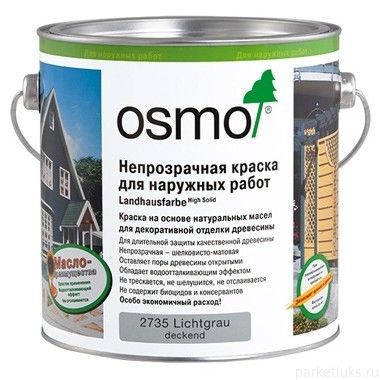 |
Opaque paintlandhausfarbe A variety of colors and unsurpassed reliability - for all weather conditions! Particularly durable and weather-resistant wood paint for outdoor use.
|
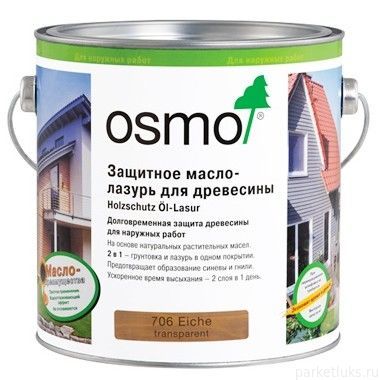 |
Protective oil-azure for woodHolz Schutz Öl lasur Primer and glaze in one product - an innovative oil-based coating for long-term wood protection!
|
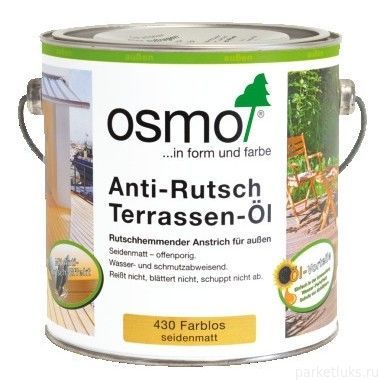 |
Terrace oilAnti-Rutsch Terrassen-Öl Anti-slip coating - reliable protection for your family! Gives the surface water-repellent properties, resistant to weathering. Especially recommended for wooden terraces |
|
Holz-Spezial-Öl Designed with individual features many noble woods |
|
|
Einmal-Lasur HS Plus High content oils provides economical consumption. Saves time and money! |
|
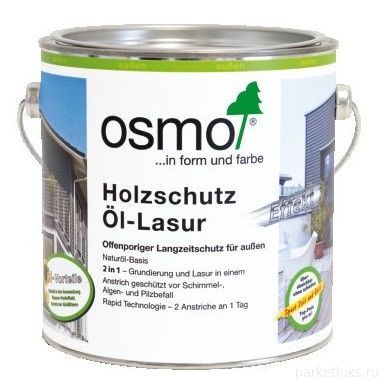 |
Protective oil-azure with silver effect Ultra trendy metallic colors! Primer and azure in one coat |
|
End wax Hirnholz-Wachs Hirnholz-Wachs Osmo End Wax is specially designed to seal the ends of logs, beams, and log cabins to protect them from cracking due to weather conditions. |
|
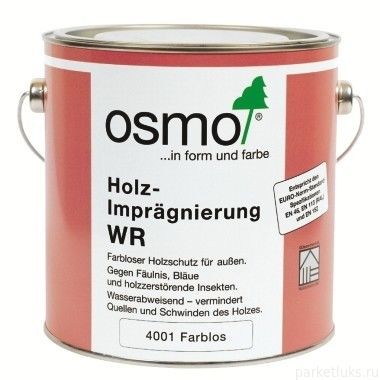 |
Wood preservativeHolz-Impragnierung WR Preventive protection against mold, blue rot and pests! For wood that does not carry static loads and does not have direct contact with the ground, for example: for window frames, doors, pergolas, facades, garden furniture, etc. It has a strong water-repellent effect. |
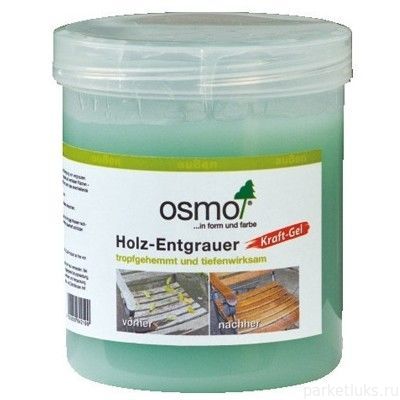 |
Holz-Entgrauer Highly effective remedy for cleaning "grayed" wood Restores the natural color of wood |
Exterior wood protection paint Osmo ( Germany)
Experiment, highlight and set the mood with Osmo Opaque Wood Colors. For connoisseurs of the natural beauty of wood, the Osmo-color program includes colorless glazing with a UV filter, as well as transparent Osmo oils for color tinting.
Create, let your imagination run wild.
Through decades of research and practical work Osmo has succeeded in creating a well-balanced outdoor wood protection system - for facades wooden houses, terraces, fences, windows, doors and garden furniture.
Osmo motto: specialized coatings for specific applications. An example of this approach is the Holz-Spezial-Öl series, which includes larch oil, teak oil, bankai oil, etc. Each product of which is designed taking into account the individual characteristics of a particular type of wood.
Osmo-paint and oil for wood fulfills any design desire.
Osmo wood oil outdoor durable and safe for environment.
Paint and oilfor wood outdoor Osmo is a protective and decorative coating for wood. Paint and oil Osmo (Osmo) is intended for painting wood and wooden structures, operated both indoors and outdoors, to cover any wooden surfaces. Paint and oil for wood Osmo (Osmo) is created on the basis of the latest research and complies with current European standards. They contain biologically active substances that provide preventive protection against the growth of staining (blue rot) and destructive (mold) fungi. Osmo's philosophy is to produce and sell only products that are safe to manufacture and use.
Many people ask:how to paint a wooden house? After all, the paint for the facade wooden house must protect wood from moisture, decay, ultraviolet rays, the harmful effects of temperature changes and various pests. OSMO outdoor paint fully meets all the above requirements, it can also be used for wooden fences. OSMO hprotective oil-azure Holz-Schutz Öl Lasur or opaque outdoor paint Landhausfarbe will provide reliable protection for the facade of a wooden house, give the tree the right color and last for many years, thanks to German quality.
A. Osmo exterior wood paint and oil has high water repellency, resistant to household chemicals, synthetic detergents and temperature fluctuations. applied to wooden surface, paint for wood Osmo (Osmo) creates a unique matte surface.
B. Wood treated with Osmo Exterior Wood Paint, based on oils and waxes, is excellent for interior decoration with high humidity(e.g. bathrooms or kitchens), is highly durable, water and dirt repellent. To freshen up a previously painted wood surface, simply apply a new coat of Osmo paint.
B. Application paints and oils Osmo for wood is very extensive. It has proven itself as a material for painting outdoor or indoor wooden structures, facades of wooden houses, windows and doors, terraces, wooden fences, skirting boards, platbands, walls and ceilings of residential premises and surfaces subject to increased wear.
For outdoor use, the variety of Osmo paints and oils is as great as for indoor use. Here it is necessary to take into account natural properties wood, its technological parameters (rotting resistance and density). For example, larch should be covered with Osmo paint without antiseptics, since it has natural protective properties, and protective azure is required for pine. Wood burns out the less, the darker the color of the paint. One of Osmo's newest additions is the UV filter oil, which is a product that protects wood from the sun and significantly reduces the number of updates, which means saving you money and time. The consumption of Osmo oils and paints may increase when applying wood with uneven surface. Also, depending on the wood and its density, the absorbency of the paint may increase. For applying Osmo paints and oils, it is better to use brushes with natural bristles. Also, Osmo paint of any color can be applied in two layers, which makes the surface brighter and more welcoming. Only dry wood should be coated - if a damp surface is covered, mold or fungus is quite likely to form. Therefore, paint the facade of a wooden house or wooden fence follows, as a rule, in the summer.
The choice of wood paint for outdoor use Osmo (Osmo) will provide not only high consumer and technological properties of wood products, but also a certain economic benefit, since paint and oil for wood Osmo (Osmo) is very economical and in most cases requires application only in one layer.
You can buy paint for a wooden house directly through the Internet or in our store. Before buying, it is recommended to do a trial painting in order to choose the paint color for the facade of the house or fence as accurately as possible.
- for interior work
- transparent, silky glossy
- Especially recommended for furniture and children's toys
- Also suitable for walls, ceilings, doors, skirting boards, decorative beams, glued wood products, chipboard, cork and flooring
- Have high strength
- Gives surfaces water and dirt repellency and stain resistance
- Number of layers: 1
- To increase the intensity of the color, repeat the coloring process.
- Can volume: 0.125 l; 0.75 l; 2.5 l; 10 l.
- For professionals, Osmo offers this product in 25 liter cans.
- Consumption: 1 liter per 20 m 2 in one layer
|
|
|
|
|
|
|
|
|
|
|
|
|
|
|
|
|
|
|
|
|
|
|
|
The wood acquires a silky-glossy, weather-resistant surface, the gloss of which can be enhanced by light polishing with an OSMO polishing pad.
Wood treated with OSMO-based oil and wax paint is excellent for finishing rooms with high humidity (for example, bathrooms or kitchens), is highly durable, has water and dirt-repellent properties.
To freshen up a previously painted wood surface, simply apply a new coat of paint.
Product Description
OSMO DEKORWACHS TRANSPARENT - transparent paint (colored oil) for wood, for interior work. After a simple painting, a professional silky-glossy surface is obtained. By lightly polishing the surface, a stronger gloss can be imparted. At the same time, the paint emphasizes the structure and texture of wood. Osmo-paint based on oils and wax transparent is created on the basis of natural vegetable oils and wax. It leaves the pores of the wood open, does not crack, flake or peel. To refresh a previously painted wooden surface, it is enough to apply a new coat of paint over the old one.
The surface treated with OSMO-based oil and wax transparent DEKORWACHS Transparent has dirt and water repellent properties, high wear resistance. Pollution is easily removed.
The surface treated with hard wax oil is resistant to stains such as wine, beer, cola, coffee, tea, juice, milk, water, etc. in accordance with DIN 68861-1C.
OSMO-based oil and wax transparent DEKORWACHS Transparent has proven itself over many years of testing, especially in rooms with high humidity.
The paint has a thick consistency, is easy to apply and does not require special care.
Oil Wax Base
Osmo-paint based on oils and wax transparent is created on the basis of natural vegetable oils and waxes. natural oils and wax penetrate deep into the wood.
They keep the wood healthy and elastic and prevent it from drying out. Wood retains its ability to breathe. Moisture evaporate. Reduces the risk of swelling and shrinkage of wood.
Health and environment
OSMO transparent oil and wax based paint DEKORWACHS Transparent does not contain any biocides or preservatives. Dried paint is safe for humans, animals, plants. It complies with German industrial standard DIN 53160 (saliva and sweat resistant) and European standard EN 71 (permitted for children's toys); all certificates are available. OSMO's principle is to produce and sell only those products that are harmless to health and safe both in production and in use. Thanks to this, OSMO paints have been certified according to DIN EN ISO 9001 for quality protection (quality management system certification) and DIN EN ISO 14001 (for environmental protection (environmental management system certification).
Areas of use
OSMO transparent oil and wax based paint is designed for wood during indoor areas: for painting walls and ceilings, decorative beams, furniture, skirting boards, toys, doors. Ideal for all wood and cork floors (see HARTWACHS-ÖL hard wax oil description).
Great for high humidity areas (kitchen, bathroom, swimming pool). Can be used on all types of wood, cork, OSB, laminated wood and chipboard (does not require a primer).
Preparatory work
The surface of wood (or cork) must be clean and dry (wood moisture content is not more than 20%). Do not apply on frozen surfaces! Old open-porous paints are easy to clean from dirt and dust. Remove varnish (using OSMO remover old paint ABBEIZER, which is biodegradable, or sanded off).
For woods that are susceptible to blue damage in rooms with high humidity (e.g. pine), we recommend first treating the wood with our biocide-free, water-repellent wood wax, HOLZPROTEKTOR, as far as possible on all sides. After that, OSMO transparent paint based on oils and wax is applied within a week.
OSMO Product Compatibility
OSMO paint based on oils and wax transparent can be applied to OSMO paint based on oils and wax, oil and wax for hard rock wood, hard wax oil, single-layer azure (including other open-porous azures, wood preservative, and wood impregnation with a water-repellent effect.
Caring for floors covered with OSMO hard wax oil
To keep the floors clean in the house, it is enough to sweep or vacuum regularly, it is very practical to use a polishing machine. Wet cleaning can be carried out by adding Vish-Fix concentrated wood cleaner to the water. Wipe the floors with a slightly damp cloth, then wipe dry.
To remove stubborn stains, OSMO offers special remedy for wood care and cleaning OSMO REINIGUNGS- UND PFLEGEMITTEL. (also in the form of a spray). Apply a little of this product to a piece of cloth or a special OSMO polishing pad (for oak floors, use a special adhesive pad) and treat problem areas. Remove dirt with a dry cloth. After the treated area has dried, lightly polish it. This product cleans and maintains the floor at the same time.
Over time, with heavy wear, floors can be easily restored with OSMO HARTWACHSÖL hard wax oil. Hard wax oil can be applied in a thin layer only on individual damaged areas of the floor, after cleaning the treated areas from contamination. In this case, the restored areas will not differ from the rest of the surface.
Moisture resistance is an important property decorative coatings. Wax for wood will help create reliable protection from moisture, will give brightness, shine, silkiness to wood. Coating based on natural ingredients will prevent scratches, chips, cracks, restore worn areas.
What are the benefits of wood wax?
The catalog of the online store Tonna Kraski has a wide range of wood protection products. Wax for wood has undeniable advantages. It is safe for health and the environment, easy to apply, improving the properties of the new and treated surface.
The universal tool is used:
- for finishing wooden and cork floors (Kreidezeit);
- to restore beauty floor covering(polish Glimtrex);
- for sealing end cuts terrace board, logs, timber (OSMO);
- to increase the moisture resistance of wood (PNZ, Teknos, Watco);
- for protection against mechanical influences, deformations, ultraviolet radiation;
- to give a bright shine and expressiveness to the natural pattern;
- for adding to care solution (Kreidezeit).
Wood wax available as solid material, suspensions, polishes (Glimtrex, Watco), glazing water-based solution (Teknos). Waxing is carried out on a dry, dust-free surface with a clean rag, brush, using a vacuum painting machine or sprayer. Kreidezeit beeswax products are applied to untreated substrates and furniture facades primed with natural oils. Finish coat quickly absorbed, giving the wood a pleasant shimmering sheen and satiny silkiness.
Why is it profitable to buy wood wax from us?
The online store Tonna Kraski is organized to fully meet the needs of customers in materials, tools, care and protection products. It is convenient to choose and buy wax for wood, polish, glazing, tinting impregnation from us and get a discount when paying for an order for a large number of goods. The rationality of the decision is obvious! You save time and money by providing the object with everything necessary for finishing, protecting and preventing wood.
Attach wooden structures and products with a pleasant shine, emphasize the beauty of the natural pattern! It is easy to buy wax for wood from us for raw surfaces and worn areas in convenient containers from 0.18l to 18l. For more information on payment and delivery, please contact a competent manager. We will be happy to conduct a consultation by phone +7 495 649 11 04.

























